Island hopping on the Capricornio
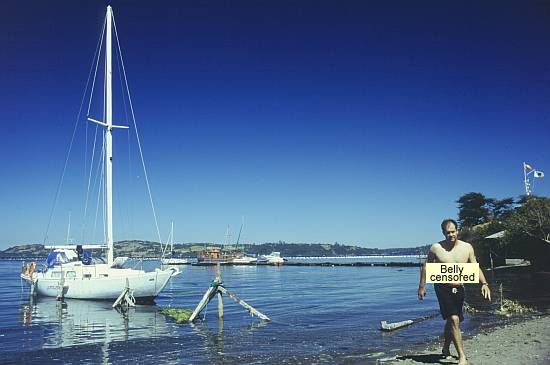 In early 2005,
which is summer at our southerly latitudes, Capt'n Germán invited
me to do another sailing trip on the Capricornio. If you have arrived on
this page without first reading about our previous
trip, you might want to take things in order and read that story first!
That said, I can assume that you have read it, and that you know very well
that sailing on this boat always involves quite a bit of work!
In early 2005,
which is summer at our southerly latitudes, Capt'n Germán invited
me to do another sailing trip on the Capricornio. If you have arrived on
this page without first reading about our previous
trip, you might want to take things in order and read that story first!
That said, I can assume that you have read it, and that you know very well
that sailing on this boat always involves quite a bit of work!
This trip started from the Quinched Marina on the main Chiloé
Island, where the Capricornio was moored after a trip the Capt'n did with his
father, former Capt'n and builder of the Capricornio. However, it had been
a slow trip, due to a thick layer of algae and barnacles that had grown
on the hull. We were in for some work before we could weigh anchor. Here
you can see our proud vessel, installed in the dry dock that nature has
build in Chiloé: The tides are so marked that even vessels much
larger than ours can easily be set dry for cleaning, just by putting it
aground and waiting for low tide!
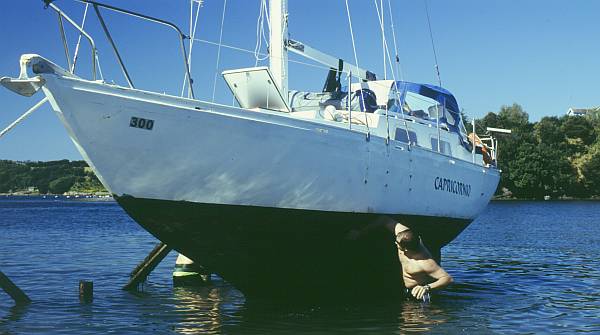 Tides reach several
meters here. But for the Capricornio, we needed just two meters, so it
was child's play! As the hull started coming out of the water, the keel
resting on logs anchored in the ground, the Capt'n and Martin started scrubbing
the hull. The Intrepid Boatswain couldn't come this time, blocked by a
lack of vacation, so that Martin filled his place. Since it was his first
time on the Capricornio, he was the "boy" for this trip!
Tides reach several
meters here. But for the Capricornio, we needed just two meters, so it
was child's play! As the hull started coming out of the water, the keel
resting on logs anchored in the ground, the Capt'n and Martin started scrubbing
the hull. The Intrepid Boatswain couldn't come this time, blocked by a
lack of vacation, so that Martin filled his place. Since it was his first
time on the Capricornio, he was the "boy" for this trip!
I did not have to do any scrubbing - my tasks were of a higher nature!
As the official photographer of the crew, I had to document the process.
As the radioman on board, I had to install my amateur HF radio. As the
Capricornio's head electronician, I also had to install the specially designed
and freshly built voltage
regulator for the dynastarter, which together with a small solar
panel regulator kept the battery voltage at the optimal level.
But the Capt'n had been working too. Since our winter trip he had taken
down the mast, replaced the last of the old and worn stays, and he had
also installed a new VHF antenna, after I signed the death certificate
for the old one, which was internally corroded to such an incredible extent
that I don't understand how we were able to do any radio contacts at all
on it, during the last trip! That antenna didn't have any real waterproofing.
Now the boat has a new Metz antenna, well sealed, well installed, which
should last many years without trouble.
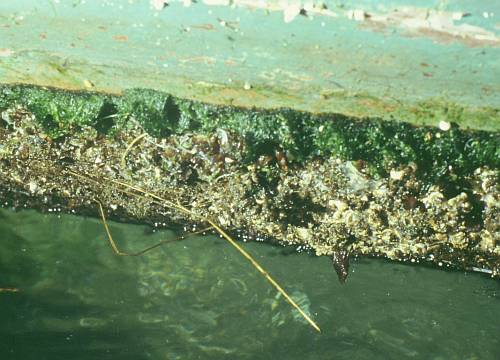 Here you can see
the sort of ecosystem that grows on boat hulls. Deep enough under the water
line, barnacles dominate the scene, while between them there are a lot
of smaller mollusks of several different sorts. Close to the water line,
a rich forest of algae grows. And above it, you can see the green antifouling
paint, which is supposed to prevent precisely this kind of marine life
proliferation in places where it isn't supposed to proliferate!
Here you can see
the sort of ecosystem that grows on boat hulls. Deep enough under the water
line, barnacles dominate the scene, while between them there are a lot
of smaller mollusks of several different sorts. Close to the water line,
a rich forest of algae grows. And above it, you can see the green antifouling
paint, which is supposed to prevent precisely this kind of marine life
proliferation in places where it isn't supposed to proliferate!
As the stuff was scrubbed off, it was tempting to catch some of it and
cook it for dinner! But unfortunately, once again, there was the Red Tide
invading the area, so that it was strictly forbidden to eat any shellfish.
For this reason, about half a ton of nice seafood fell to the ground. Most
of it probably soon gained a new foothold (or should I say shellhold?)
on nearby rocks and, of course, on other vessels!
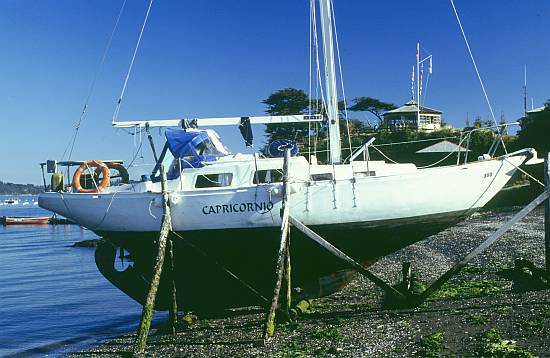 A while later,
the tide had gone down enough to put the Capricornio dry. Here you can
see it in all its majesty! The whole weight rests on its lead-filled steel
keel. While the water was starting to go down, the Capt'n had moved some
cargo so that the sloop heeled a slight bit to starboard. As a result,
it was now mightily compressing the fenders against the lateral supports.
A good thing, because on the other side there were no such supports, and
if the sloop had fallen to port, the game would have been over!
A while later,
the tide had gone down enough to put the Capricornio dry. Here you can
see it in all its majesty! The whole weight rests on its lead-filled steel
keel. While the water was starting to go down, the Capt'n had moved some
cargo so that the sloop heeled a slight bit to starboard. As a result,
it was now mightily compressing the fenders against the lateral supports.
A good thing, because on the other side there were no such supports, and
if the sloop had fallen to port, the game would have been over!
We also made a provisional repair to the helmport, which was taking
on lots of water because the nut of the helm bushing had failed,
so that the whole bushing was turning with the shaft, and had worked loose
in the wood! The bad nut was cut, reduced in size, and re-installed with
a stainless steel clamp holding it together and lots of caulk filling up
the voids. We finished that work late in the night, when the tide was already
coming back and we were getting wet feet.
Then the Capt'n sent us to sleep. He would wait for high tide, which was
at about 3 AM, and take the boat back to its anchoring site alone. I can
tell you, it's an uneasy feeling to walk around on and in a boat that
is standing on its keel! It must feel similar to sit under Damocles' sword!
All went well, and while the Boy and I were fast asleep, the Capt'n
waited for his yacht to come afloat, and anchored it in the bay of Quinched.
He was so kind to us that he didn't even start the noisy engine, but instead
did the whole maneuver just with oars!
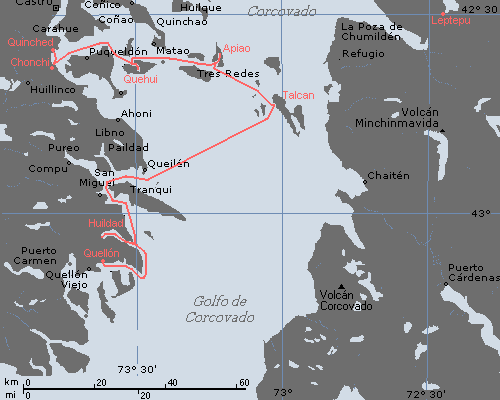 This trip was basically
from Quinched to Quellón, where the Capt'n would take another sailor on board
and then continue south. But that's a rather short trip, so we did a quite
significant detour and went island hopping along the Desertores group, with only
an approximate plan on which places we would visit.
This trip was basically
from Quinched to Quellón, where the Capt'n would take another sailor on board
and then continue south. But that's a rather short trip, so we did a quite
significant detour and went island hopping along the Desertores group, with only
an approximate plan on which places we would visit.
Alfonso Gonzales drew us another map, so you can see the trip we finally did.
This place is just south of the area where we sailed on the previous trip.
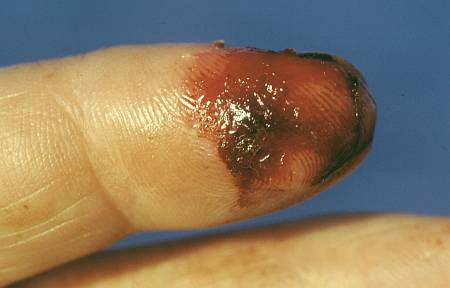 Look at my poor,
mangled finger! The culprit was, who else, the Boy! This happened the next
day, after we had weighed anchor and sailed to the nearby port of Chonchi
to take on some freshwater. The marina's well had dried up, so we had to
resort to Chonchi, which is a moderately sized town and has a regular water
supply.
Look at my poor,
mangled finger! The culprit was, who else, the Boy! This happened the next
day, after we had weighed anchor and sailed to the nearby port of Chonchi
to take on some freshwater. The marina's well had dried up, so we had to
resort to Chonchi, which is a moderately sized town and has a regular water
supply.
While the Capt'n was on land, asking where to get water, we stayed aboard
the boat. Then the Capt'n came back, and told us to pull the Capricornio astern
a short stretch and make tight alongside another vessel, from which we
would get a water hose. So we pulled along the other vessel we had been
tied too, and then had to coast over a gap to reach the vessel which had
water for us. But the Boy, who was at the bow, misjudged the course he
had to give our boat to land where we had to, and instead gave it an extra
strong push, which sent us stern-first onto a collision course with the
much larger vessel! So I leaned out over the stern, to hold onto the other
vessel as soon as I could, and applied all the force possible to slow down
our vessel before impact. I was successful at that, making the impact soft
enough to even avoid scratching anyone's paint, but then I couldn't get
my hand off the other vessel! I hadn't noticed, of course, that the plank
I grabbed had a nasty, sharply pointed, rusty nail on the backside, which
had gone deep into my index finger! I finally ripped the hand off the plank
- I couldn't stay there for good, after all - but a fair part of
my finger stayed put to the nail.
You might remember from teh previous story that I have an easily upset
stomach, and that applies not only to seasickness, but also to seeing blood,
very specially when it is my own. So I retired into the cabin, and in a
matter of five minutes I was in a full blown shock, lying on the floor,
feeling hot and cold at the same time, unable to control my body, while
in my head I was perfectly fine, knowing that as long as the wound bled
enough to clean itself, I would be fine. When the Capt'n found me there
in my sorry state, he wanted to haul me to Chonchi's first aid station,
but I convinced him that in another 15 minutes I would be fine. And so
it was.
The whole accident had a good side to it: Since the wound had to be
kept dry, I was excused from dishwashing service for the duration of the
trip! The Boy had to take my turns washing dishes!
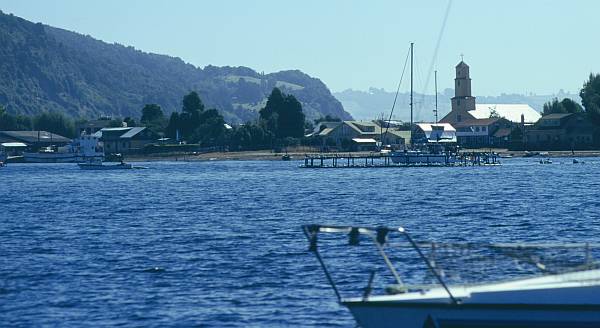 The first island
on our tour was Quehui. Just a few sailing hours from Chonchi, this place
offers a nice landscape, and a very good port. The island has roughly the
shape of a horseshoe, only that the entrance is much narrower, maybe 100
meters wide and a few hundred meters long. The inside bay is completely
protected from waves from any side, and protected from most wind
directions too. A large amount of vessels, from small boats to middle-sized
ships, were anchored, stranded, moored here. There was a tiny village,
complete with a modest supermarket, and all over the hills there were wooden
houses. For roughly every three houses there was a church. A few hundred
years ago, the Jesuits came here and organized the locals to build them,
in very generous amounts and sizes.
The first island
on our tour was Quehui. Just a few sailing hours from Chonchi, this place
offers a nice landscape, and a very good port. The island has roughly the
shape of a horseshoe, only that the entrance is much narrower, maybe 100
meters wide and a few hundred meters long. The inside bay is completely
protected from waves from any side, and protected from most wind
directions too. A large amount of vessels, from small boats to middle-sized
ships, were anchored, stranded, moored here. There was a tiny village,
complete with a modest supermarket, and all over the hills there were wooden
houses. For roughly every three houses there was a church. A few hundred
years ago, the Jesuits came here and organized the locals to build them,
in very generous amounts and sizes.
Most of the island is in agricultural use, mostly potatoes. According
to the locals, this island's potatoes are the world's best! No wonder,
given that the climate and soil is ideal for them, while the relative isolation
of the island gives some measure of protection from invading parasites.
Some cattle ranching is also done.
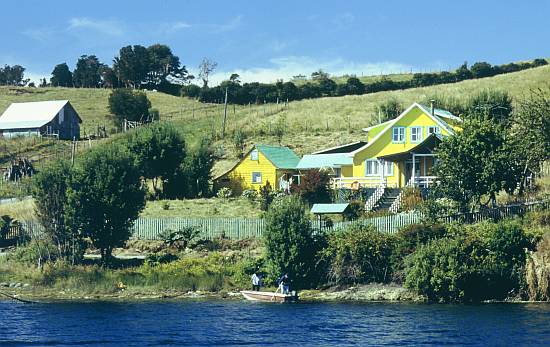 We made fast to
a buoy that was anchored in front of this house, which belongs to a friend
of the Capt'n, who lives and works a little more than 2000km away, but
comes to this place on many weekends, by plane, bus and boat. His sloop
was there, so we assumed he too was there. The Capt'n blew his beloved
foghorn, which made people come out of all houses within sight, to find
out who on earth was making such a lot of noise. Among them was his friend,
who looked, went away, returned with binoculars, looked again, then disappeared
for good.
We made fast to
a buoy that was anchored in front of this house, which belongs to a friend
of the Capt'n, who lives and works a little more than 2000km away, but
comes to this place on many weekends, by plane, bus and boat. His sloop
was there, so we assumed he too was there. The Capt'n blew his beloved
foghorn, which made people come out of all houses within sight, to find
out who on earth was making such a lot of noise. Among them was his friend,
who looked, went away, returned with binoculars, looked again, then disappeared
for good.
After waiting a long time, we inflated the dinghy and landed, to pay
him a visit. There we heard a fun example of how the human mind sometimes
works, or rather, doesn't work: The guy had heard the foghorn, noticed
a freshly arrived sloop, gone for his binoculars, and read the name, Capricornio.
Then he had reasoned: "Funny, I know a guy who has a sloop with the same
name. And it looks very similar, what a coincidence!" After thinking that,
he had returned to his house! The idea that indeed it was the Capricornio,
and that his friend was there, trying to invite him aboard for a glass
of rum, didn't cross his mind! He thought the Capricornio was still far
away in Antofagasta!
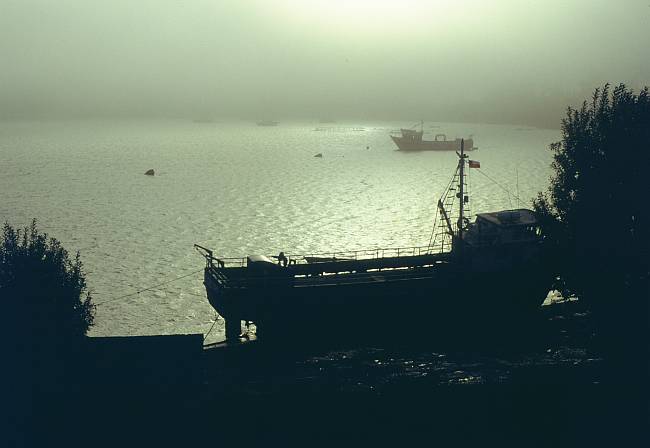 The Capt'n invited
him on board, they downed their rum, and then it was our turn to be invited
for dinner, and specially, for a hot shower. Anyone who has traveled on
a bathroom-less yacht knows that such an offer is valuable!
The Capt'n invited
him on board, they downed their rum, and then it was our turn to be invited
for dinner, and specially, for a hot shower. Anyone who has traveled on
a bathroom-less yacht knows that such an offer is valuable!
In the late afternoon a generous low-flying cloud paid a visit, giving
me an enchanting opportunity to shoot some fog photos. It's impressive
how much a landscape can change its expresssion thanks to fog and counterlight,
turning from an idyllic little toybox paradise into a dreamy, moody seascape!
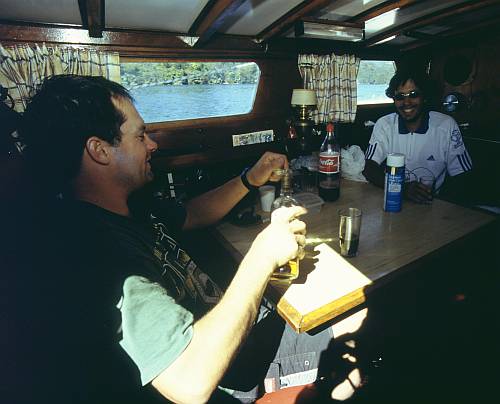 Check any stylish
sailing novel, specially one involving pirates and treasure islands complete
with buried chests, and you will learn that captains and rum belong together
like wind and sail, anchor and chain, or barnacles and hulls. Here you
can admire our Capt'n's long honed skill in pouring rum. He doesn't spill
even one droplet, regardless of how rough the sea may be. Not that it would
have been rough this day, anyway... The Boy instead gets just Coca
Cola - there wasn't enough rum on board for him. And the can of contact
cleaner, well, that one was for me, and certainly not for drinking! :-)
Check any stylish
sailing novel, specially one involving pirates and treasure islands complete
with buried chests, and you will learn that captains and rum belong together
like wind and sail, anchor and chain, or barnacles and hulls. Here you
can admire our Capt'n's long honed skill in pouring rum. He doesn't spill
even one droplet, regardless of how rough the sea may be. Not that it would
have been rough this day, anyway... The Boy instead gets just Coca
Cola - there wasn't enough rum on board for him. And the can of contact
cleaner, well, that one was for me, and certainly not for drinking! :-)
Truth be told: The Capricornio was working very well. We were just fixing
minor details at this time, things like the anchor chain stowage compartment
lighting, which is used perhaps once a year. And I installed a 12 Volt
distribution box with multiple cigarette lighter outlets, not for cigarette
lighters but for the many accessories that were used on this trip: Two
GPS receivers, two cellphone chargers, a vacuum cleaner, a charger for
my VHF handheld radio, and so on.
Speaking of radios, for this trip I brought my HF transceiver and a
specially built antenna tuner, and spent a good number of hours making
contacts as station XQ2FOD/MM. A sloping aftstay, loaded against the salt
water plane, makes an excellent all-band HF antenna! In fact, it's what
most sailing boats of this size use as antenna for their marine HF radio.
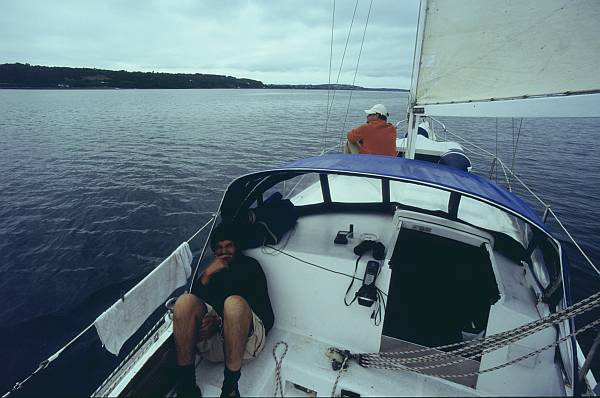 From Quehui we
sailed to the island of Apiao. It was a very lazy trip. The Capt'n was
hanging out at the bow, but since he was too lazy to stand, he sat down..
The Boy held his siesta, which lasted, well, for most of the day. It was
an overcast day, with light wind, and comfortable temperature.
From Quehui we
sailed to the island of Apiao. It was a very lazy trip. The Capt'n was
hanging out at the bow, but since he was too lazy to stand, he sat down..
The Boy held his siesta, which lasted, well, for most of the day. It was
an overcast day, with light wind, and comfortable temperature.
For this trip, the Capricornio had finally gotten its rain deck. This really
adds to the comfort on board! One can leave the hatch open even when it
rains, one can sit there dry and protected from the wind, and in addition
it creates a place where one can leave binoculars, GPS receivers, photo
gear, pieces of clothing, and other stuff, always well at hand, while staying
dry, and it doesn't slide into the water if the sloop suddenly banks!
The Capt'n had his doubts about going to Apiao. When he asked about
the island and its waters, very strange stories came up. The Chiloe archipelago
is by far the place in Chile that has most stories of strange encounters,
the biggest family of mythological beings, and the most folkloric tales.
There are big guides of all these good and bad monsters, the Cai-Cai-Vilú
and many others, printed in book form, for sale in bookstores. And according
to the stories that we were told about Apiao, it seems that this island
is where they all have their headquarters!
Several people advised us not to go there, because the devil, not to
speak of an assortment of monsters, were surely waiting for us. When the
Capt'n kept asking a self-appointed witch what we had to do to get safely
to Apiao, finally she surrendered: "If you go there in good faith and with
best intentions, you shall have luck. Go, but don't think any bad thoughts."
A more down-to-sea fact is that entering Apiao has always been a hairy
business. The island is almost round, with a big internal lagoon, connected
to the ocean only through a long, very narrow and shallow channel. Due
to the strong tides, this channel carries heavy currents, which further
complicates navigating it. I guess that this channel is the reason why
the stories place so many monsters there!
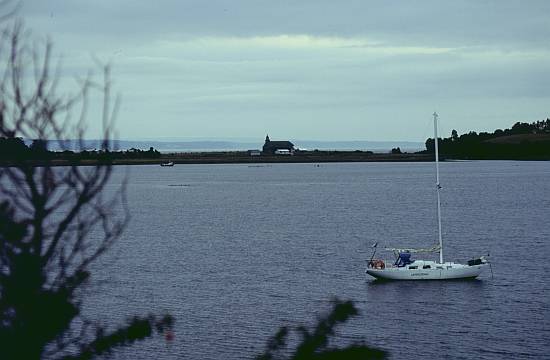 Well, we did it,
and here you can see the Capricornio proudly anchored in the lagoon of
Apiao. But it wasn't without some funny stories that we got here!
Well, we did it,
and here you can see the Capricornio proudly anchored in the lagoon of
Apiao. But it wasn't without some funny stories that we got here!
When we arrived on the outside of the island, the Boy and I went to
land in the dinghy to get directions, while the Capt'n stayed on board.
At that place we supposed was the inlet to the channel, but it couldn't
be seen, so narrow and winding was it. We rowed to the shore, since the
dinghy's little outboard engine apparently had been killed during routine
maintenance by an inept mechanic. On the shore we had seen a fisherman.
But as we came close, the fisherman ran away as if we had some horrible
disease, and by the time we landed, he had hidden out of reach! Very strange
place indeed, this island...
We went searching, and after a while we found someone else, approaching
quickly enough so he couldn't run. That man was very kind, and even seemed
rather normal! He gave us some good advice about how to negotiate the passage.
We waited for almost high tide, then entered the channel, on engine
power. The Capt'n was watching the bottom from the bow, I was at the tiller,
the Boy babysitting the depht finder. The Capt'n kept asking me to go slower.
The Capricornio really lacks a first gear for cases like this! I just couldn't
throttle down the Volvo Penta any further without killing it!
We slowly advanced into the narrow passage, the Capt'n giving his orders,
and I obeying. "Twenty degrees port!" I pushed on the tiller. A moment
later: "Rock in sight! Thirty starboard!" Around the tiller went... I worked
up a nice sweat!
Sometimes the Capt'n simply pointed to which side he wanted us to go.
Then at one place it got very shallow indeed, with rocky bottom. The Boy
reported fifty centimeters of water under the keel, and the Capt'n got
nervous. Suddenly he pointed left like mad, while shouting "Starboard!
Starboard! Staaaaarboard!!!!"
To err is human, they say... But this little glitch almost made us run
aground!
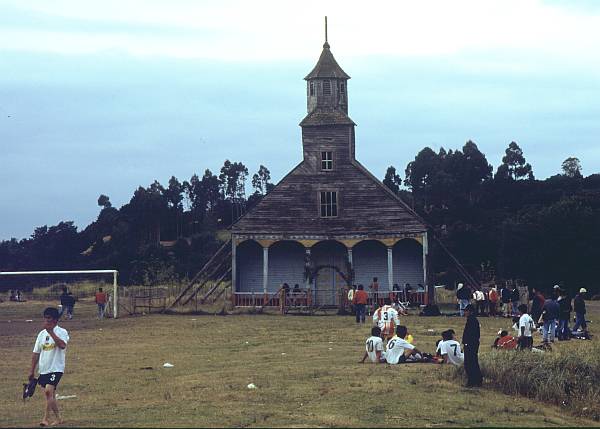 In front
of the island's main Jesuit-built church we found a lively soccer match
going on. We talked to several islanders, and learned some interesting
facts: This island, which has maybe 300 inhabitants, has 13 soccer teams!
Clearly, some islanders must be playing on two or three teams, or it wouldn't
work out. After all, ladies don't play soccer here, and there are some
babies and very old gents too who probably cannot!
In front
of the island's main Jesuit-built church we found a lively soccer match
going on. We talked to several islanders, and learned some interesting
facts: This island, which has maybe 300 inhabitants, has 13 soccer teams!
Clearly, some islanders must be playing on two or three teams, or it wouldn't
work out. After all, ladies don't play soccer here, and there are some
babies and very old gents too who probably cannot!
The first person to greet us here was actually a foreigner - well, almost:
He lives in Santiago, and spends every summer here on Apiao. He told us
that we could broadly divide the islanders into just two types: The drunkard,
and the son of God. Both alcohol and an evangelic faith are very powerful
here. The catholic church in this photo, instead, gets little use and is
in severe disrepair.
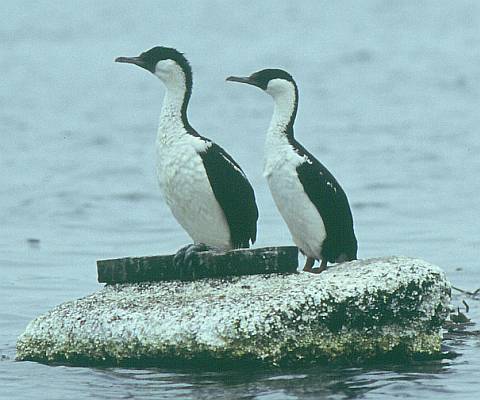 Crossing
the lagoon back from the soccer field, we saw many seabirds, including
a flock of imperial cormorants. These two were resting on an old buoy,
and were trusting enough to let us come very close, while I shot my photos.
Crossing
the lagoon back from the soccer field, we saw many seabirds, including
a flock of imperial cormorants. These two were resting on an old buoy,
and were trusting enough to let us come very close, while I shot my photos.
We spent a good while in the dinghy, then landed on the opposing side
of the island. There is a landing strip, built by a salmon farming company
and now rarely used, and a little school. Walking along the landing strip
came a guy, who certainly was in some trouble, because his zigzag was as
wide as the strip! When he got close, he stopped, greeted, told us his
many names including several handles, those of his family, friends and
relatives, in such a slurry speech that we had trouble staying serious!
The smell of booze almost made us drunk ourselves. We tried to get him
to tell us about the crossing to Talcan Island. After all, most people
here are seamen and know the area inside and out, even when they are drunk.
His answer, when we finally managed to understand it, was very folklike,
to say the least, and could be translated roughly like "Don't go there,
it's !@#$%^&* rotten, (*&^%$ ugly, #$%^&(*&#$% bad!" After
the enormous effort of putting the words together, well, almost, the guy
sank to his knees, then fell on his side, and slept, in the middle of the
island's runway. We left him there, since it was evening and surely no
plane would try to land in the light. Probably the next morning the man
would be sober early enough, and working again...
We continued the walk, towards the school and a few houses. On the road
we met another man, who was walking very straight, and smiling. We greeted
him, and he greeted back: "In the name of God, welcome to our island."
We tried some small talk about the beauty of the place. "Yes, it is beautiful,
because God created it, and He does no wrong." We asked him about sailing
to Talcan Island. "If you want to go there, God will surely help you."
Not very informative, I would say... We switched matters, and asked about
the weather, if any storm was expected. "By the grace of God, the weather
will be fine. It always is, for God makes it." And these clouds above
us? "By God, they are beautiful, aren't they? God made them!" And
so it went. We learned that God had helped build the school, that God also
had let them built a temple, a real one, small but true, for the grace
of God of course, and that this was most certainly NOT the catholic church
on the other side of the island!
It must be great to be able to live such a simple life, having a single
explanation for everything, past, present and future!
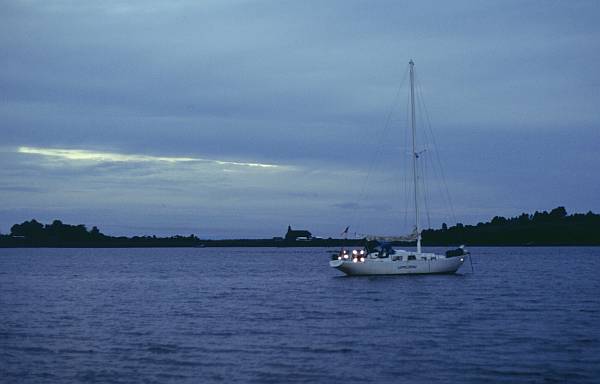 We returned
to our boat, still laughing from our encounters with such great samples
of the two categories of people inhabiting Apiao. We never expected the
description of the summer resident to be that accurate!
We returned
to our boat, still laughing from our encounters with such great samples
of the two categories of people inhabiting Apiao. We never expected the
description of the summer resident to be that accurate!
This photo is a testimony to the incredible effectiveness of the retroreflecting
bands on the Capricornio's new life preservers. I used my flash to lighten up
the sloop, when shooting this picture from the beach at f/1.4. Despite
the distance, which makes the flash light barely noticeable on the boat,
the reflectors shine like high powered beam lamps!
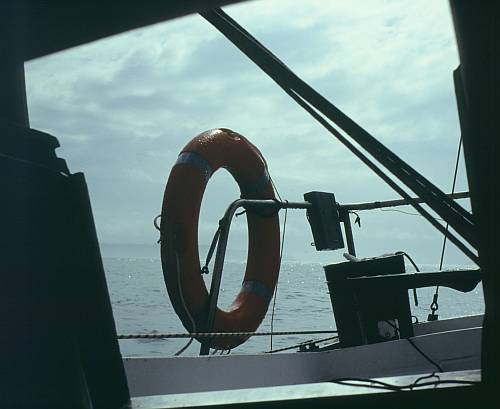 The next day
we negotiated the Apiao channel back into open waters, and then sailed
to Talcan. We had good wind and relatively calm sea, but it soon started
raining, and kept doing so intermittently during all the day. As a result,
my photographic action was mostly confined below deck, like here, looking
out through the hatch.
The next day
we negotiated the Apiao channel back into open waters, and then sailed
to Talcan. We had good wind and relatively calm sea, but it soon started
raining, and kept doing so intermittently during all the day. As a result,
my photographic action was mostly confined below deck, like here, looking
out through the hatch.
The Capricornio was in very good condition, sailing basically alone, in autopilot
mode. The solar panel didn't do much good this day, of course, but the
battery bank is large enough to run the necessary electric and electronic
equipment for several days, giving the engine a rest while there is enough
wind.
We got some low fog, which cut the visibility to a few hundred meters
and made us navigate just by the map and the GPS. Despite the rainy weather,
it was a calm, comfortable sailing, thanks to functioning technology and
the rain deck! We even had music! Before this trip, I had repaired the
boat's music radio, which had gotten waterlogged a year before, and the
Capt'n played the only two cassettes on board, in alternating fashion.
One of them was of German sailor songs, and the other, oh well, was of
German sailor songs too! After the umpteenth time listening to the same
songs, I came to regret having fixed that damn radio!
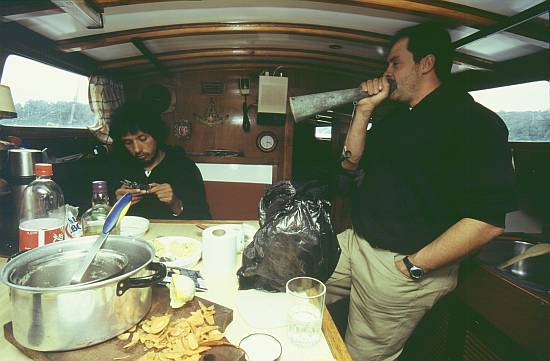 Once we arrived
at the Edwards Bay of Talcan Island, the last one in the Desertores
group, rain set in with full force, together with some strong wind,
from which the bay protected us quite well. So we spent the evening making
a good dinner, as you can see here: The Capt'n giving the orders, the Boy
peeling potatoes!
Once we arrived
at the Edwards Bay of Talcan Island, the last one in the Desertores
group, rain set in with full force, together with some strong wind,
from which the bay protected us quite well. So we spent the evening making
a good dinner, as you can see here: The Capt'n giving the orders, the Boy
peeling potatoes!
This part of Talcan Island is almost completely uninhabited, and covered
by dense jungle. It's an extremely beautiful place. It's one of the last
islands of the Chiloé archipelago, going west to east, and so close
to the continent that it already shares the continent's mountain-influenced
climate and vegetation style: Much more rain and much more green than just
40km west. Actually, we heard on my HF radio that the weather back on the
main island of Chiloé was still sunny! Here it was raining, most
certainly!
When the evening came, we understood why this bay is devoid of humans:
There is no room for them, since it's all taken up by enormous and viciously
voracious mosquitoes! As soon as the wind got weak, they came flying in
squads from the forest, and attacked us without the slightest pity! We
closed the hatches, as best we could, but they kept creeping in. In despair,
the Capt'n resorted to chemical weaponry in the form of a can of insecticide,
but it didn't seem to harm them the slightest bit! Finally, we had to weigh
anchor and move the boat into the middle of the bay, where it was harder
for them to reach us!
At this point it had been several days since the last shower, and the
level of despair was high enough to try bathing in the very cold sea. The
Boy went first, then it was my turn. I rowed to the rocky shore, took off
my pants, and tried to get into the water satisfying all necessary conditions:
Not freezing, keeping the dinghy from being blown away by the wind,
and keeping my injured finger dry! So I put one leg over board, trying
to get a firm hold on a slippery rock Then the other leg. And then a gust
came, I slipped on the rock, lost balance, tried to hold to the dinghy,
failed, fell head first into the water with most of my clothes still on,
slammed my poor finger hard against a rough rock under water, and had to
swim like crazy to catch the dinghy!
Bad things rarely come alone, they say...
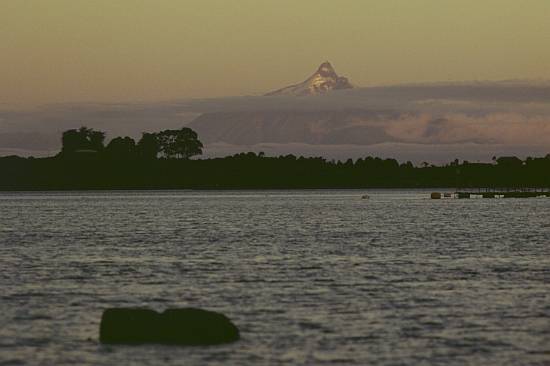 Due to a moderate
storm, we spent a full day in Edwards Bay. I used that day to finally fix
the dinghy's outboard engine. The mechanic who got his hands on it had
mounted the reed valve in a very unclever position, so it didn't work.
It was easy to find, fortunately! But I found it only after taking the
whole engine apart, and in the murky light I didn't see in time that this
engine has a roller bearing between the connecting rod and the crankshaft,
that falls apart when disassembling this area. So, we had to pick up 45
little steel rollers from the boat's floor and bilge... At least,
the engine worked after reassembling it, and that's usually a very good
sign!
Due to a moderate
storm, we spent a full day in Edwards Bay. I used that day to finally fix
the dinghy's outboard engine. The mechanic who got his hands on it had
mounted the reed valve in a very unclever position, so it didn't work.
It was easy to find, fortunately! But I found it only after taking the
whole engine apart, and in the murky light I didn't see in time that this
engine has a roller bearing between the connecting rod and the crankshaft,
that falls apart when disassembling this area. So, we had to pick up 45
little steel rollers from the boat's floor and bilge... At least,
the engine worked after reassembling it, and that's usually a very good
sign!
Then we sailed back west, straight across open waters, on the longest
leg of our trip, about ten hours. We passed by Queilén, and then
navigated the wide and calm channel between Tranqui Island and the the
main Chiloé Island. On this photo you can see the Corcovado Volcano,
with the southern tip of Tranqui in the foreground. The 2300 meter high
volcano is on the continent, raising straight out of the sea. Between the
volcano and the island there are 50km of water.
The channel is full of activity, mostly salmon farms and also some shellfish
farms. One has to steer around all the buoys and other markers, pass between
floating cages, and also evade occasional sargasso banks.
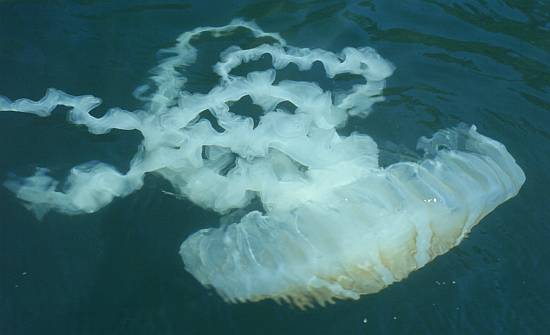 Sargasso wasn't
the only kind of sea life that was thick in these waters. Jellyfish were
too! We saw them everywhere, in all sizes and states of maturity, dead
and alive. This one was photographed from the dinghy in the bay of
Huildad, where we anchored that evening after crossing the sea from Talcan
Island. With the newly fixed outboard engine, we zapped around our anchorage,
photographed sea birds, including some blackneck swans which found refuge
here after fleeing their home near Valdivia, where their staple food, tiny
algae, died out because of pollution apparently coming from a new cellulose
plant. The plant had been closed down and the situation was being investigated,
but the birds had already lost their home, at least temporarily.
Sargasso wasn't
the only kind of sea life that was thick in these waters. Jellyfish were
too! We saw them everywhere, in all sizes and states of maturity, dead
and alive. This one was photographed from the dinghy in the bay of
Huildad, where we anchored that evening after crossing the sea from Talcan
Island. With the newly fixed outboard engine, we zapped around our anchorage,
photographed sea birds, including some blackneck swans which found refuge
here after fleeing their home near Valdivia, where their staple food, tiny
algae, died out because of pollution apparently coming from a new cellulose
plant. The plant had been closed down and the situation was being investigated,
but the birds had already lost their home, at least temporarily.
I'm digressing... Back to the jellyfish! Its disc was about one meter
in size, and it didn't want to pose for the photo! Martin coaxed it into
a photogenic position with the oars, but as soon as he pulled them in so
I could make a photo, the jellyfish aimed downwards and hid its beautiful
colors! These animals might be primitive, but even they have learned that
facing something unknown, it's safest to run away!
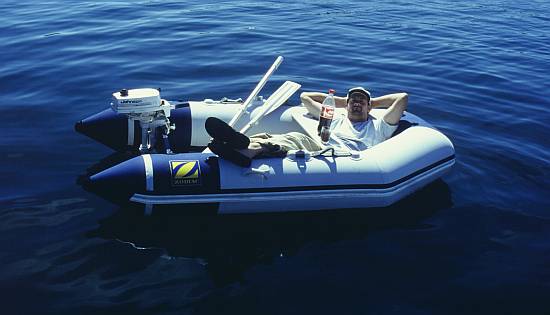 Our Capt'n at
work! Only that he had run out of rum, so he had to steal the Boy's cola
bottle! I caught him working in this way, the next day. It was a lazy day,
our last on this trip. Everything except one device on board had been repaired,
the weather was nice, and we had just had a half day's sailing in store
to reach Quellón, the destination port of our trip. So we spent
the morning in Huildad.
Our Capt'n at
work! Only that he had run out of rum, so he had to steal the Boy's cola
bottle! I caught him working in this way, the next day. It was a lazy day,
our last on this trip. Everything except one device on board had been repaired,
the weather was nice, and we had just had a half day's sailing in store
to reach Quellón, the destination port of our trip. So we spent
the morning in Huildad.
The Boy and I went fishing in the dinghy. He caught a beautiful salmon.
But he has a sort of agreement with Poseidon, which consists in giving
back the first fish he catches on any given day. So he put the salmon back
in the water. Either that salmon quickly ran and told all others not to
bite that tricky thing, or it was Poseidon who was offended by the Boy
refusing his gift! In any case, Martin didn't fish anything else, and we
had to open our last cans of tuna!
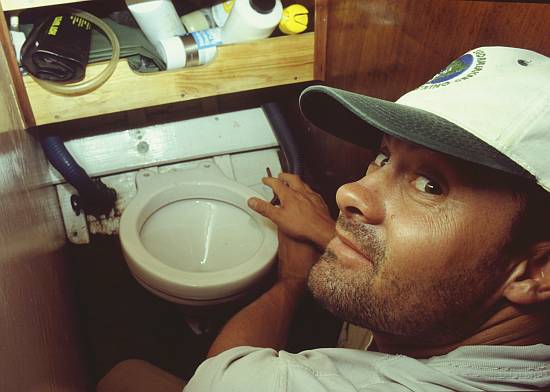 It has often been
said that everyone on earth has to pay for his deeds. After spending so
much time "working" in his very own way, the Capt'n, being the closest
thing to an hydraulic engineer on board, had to fix the loo when it choked
for good! This high-tech device has a number of valves, a pump, and is
cleverly designed to work like a charm. You do your thing, then pump a
few strokes on a handle, and all is nice and clean.
It has often been
said that everyone on earth has to pay for his deeds. After spending so
much time "working" in his very own way, the Capt'n, being the closest
thing to an hydraulic engineer on board, had to fix the loo when it choked
for good! This high-tech device has a number of valves, a pump, and is
cleverly designed to work like a charm. You do your thing, then pump a
few strokes on a handle, and all is nice and clean.
But after 30 years at sea, the charm had evaporated for the most part.
As it was by this time, you had to haul a bucket of water in, wet the bowl,
do your thing, then combine pumping with pouring water from the bucket,
and while pumping, water would sprinkle in all directions and finally flood
the area. At least, that was how it went while the boat was anchored,
or running under engine power. When sailing, the results of any attempt
to use the loo depended on wind direction: Port, and you had to haul
three buckets of water because the pump wouldn't prime. Starboard,
and you got a wet stern!
In any case, the Capt'n dug deep in what he found there, replaced seals,
unclogged valves, and then the loo was like new!
With the Capricornio functioning like a dream, we left Huildad in the
mid afternoon and sailed to Quellón, a little bit sad because this
trip had been all too short. But vacations were running out - they are
never long enough! We passed by the Chaiguao Point in late afternoon, and
then had a gorgeous sailing along the Quellón channel, into the
setting sun, reaching port when the night had come and enveloped ships
and men in its black cloak.
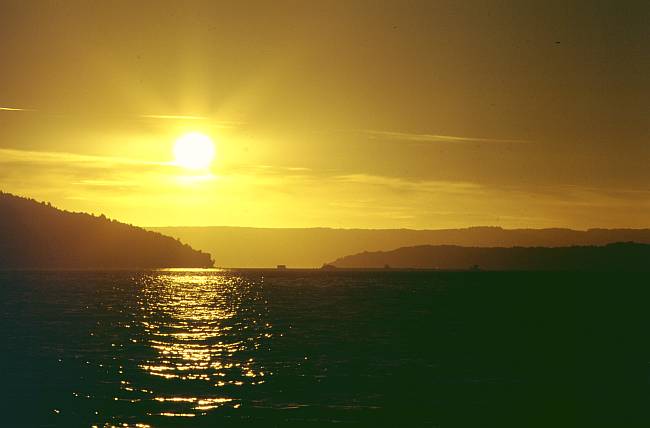
Back to the homo ludens nauticus
index.
 In early 2005,
which is summer at our southerly latitudes, Capt'n Germán invited
me to do another sailing trip on the Capricornio. If you have arrived on
this page without first reading about our previous
trip, you might want to take things in order and read that story first!
That said, I can assume that you have read it, and that you know very well
that sailing on this boat always involves quite a bit of work!
In early 2005,
which is summer at our southerly latitudes, Capt'n Germán invited
me to do another sailing trip on the Capricornio. If you have arrived on
this page without first reading about our previous
trip, you might want to take things in order and read that story first!
That said, I can assume that you have read it, and that you know very well
that sailing on this boat always involves quite a bit of work!
 Tides reach several
meters here. But for the Capricornio, we needed just two meters, so it
was child's play! As the hull started coming out of the water, the keel
resting on logs anchored in the ground, the Capt'n and Martin started scrubbing
the hull. The Intrepid Boatswain couldn't come this time, blocked by a
lack of vacation, so that Martin filled his place. Since it was his first
time on the Capricornio, he was the "boy" for this trip!
Tides reach several
meters here. But for the Capricornio, we needed just two meters, so it
was child's play! As the hull started coming out of the water, the keel
resting on logs anchored in the ground, the Capt'n and Martin started scrubbing
the hull. The Intrepid Boatswain couldn't come this time, blocked by a
lack of vacation, so that Martin filled his place. Since it was his first
time on the Capricornio, he was the "boy" for this trip!
 Here you can see
the sort of ecosystem that grows on boat hulls. Deep enough under the water
line, barnacles dominate the scene, while between them there are a lot
of smaller mollusks of several different sorts. Close to the water line,
a rich forest of algae grows. And above it, you can see the green antifouling
paint, which is supposed to prevent precisely this kind of marine life
proliferation in places where it isn't supposed to proliferate!
Here you can see
the sort of ecosystem that grows on boat hulls. Deep enough under the water
line, barnacles dominate the scene, while between them there are a lot
of smaller mollusks of several different sorts. Close to the water line,
a rich forest of algae grows. And above it, you can see the green antifouling
paint, which is supposed to prevent precisely this kind of marine life
proliferation in places where it isn't supposed to proliferate!
 A while later,
the tide had gone down enough to put the Capricornio dry. Here you can
see it in all its majesty! The whole weight rests on its lead-filled steel
keel. While the water was starting to go down, the Capt'n had moved some
cargo so that the sloop heeled a slight bit to starboard. As a result,
it was now mightily compressing the fenders against the lateral supports.
A good thing, because on the other side there were no such supports, and
if the sloop had fallen to port, the game would have been over!
A while later,
the tide had gone down enough to put the Capricornio dry. Here you can
see it in all its majesty! The whole weight rests on its lead-filled steel
keel. While the water was starting to go down, the Capt'n had moved some
cargo so that the sloop heeled a slight bit to starboard. As a result,
it was now mightily compressing the fenders against the lateral supports.
A good thing, because on the other side there were no such supports, and
if the sloop had fallen to port, the game would have been over!
 This trip was basically
from Quinched to Quellón, where the Capt'n would take another sailor on board
and then continue south. But that's a rather short trip, so we did a quite
significant detour and went island hopping along the Desertores group, with only
an approximate plan on which places we would visit.
This trip was basically
from Quinched to Quellón, where the Capt'n would take another sailor on board
and then continue south. But that's a rather short trip, so we did a quite
significant detour and went island hopping along the Desertores group, with only
an approximate plan on which places we would visit. Look at my poor,
mangled finger! The culprit was, who else, the Boy! This happened the next
day, after we had weighed anchor and sailed to the nearby port of Chonchi
to take on some freshwater. The marina's well had dried up, so we had to
resort to Chonchi, which is a moderately sized town and has a regular water
supply.
Look at my poor,
mangled finger! The culprit was, who else, the Boy! This happened the next
day, after we had weighed anchor and sailed to the nearby port of Chonchi
to take on some freshwater. The marina's well had dried up, so we had to
resort to Chonchi, which is a moderately sized town and has a regular water
supply.
 The first island
on our tour was Quehui. Just a few sailing hours from Chonchi, this place
offers a nice landscape, and a very good port. The island has roughly the
shape of a horseshoe, only that the entrance is much narrower, maybe 100
meters wide and a few hundred meters long. The inside bay is completely
protected from waves from any side, and protected from most wind
directions too. A large amount of vessels, from small boats to middle-sized
ships, were anchored, stranded, moored here. There was a tiny village,
complete with a modest supermarket, and all over the hills there were wooden
houses. For roughly every three houses there was a church. A few hundred
years ago, the Jesuits came here and organized the locals to build them,
in very generous amounts and sizes.
The first island
on our tour was Quehui. Just a few sailing hours from Chonchi, this place
offers a nice landscape, and a very good port. The island has roughly the
shape of a horseshoe, only that the entrance is much narrower, maybe 100
meters wide and a few hundred meters long. The inside bay is completely
protected from waves from any side, and protected from most wind
directions too. A large amount of vessels, from small boats to middle-sized
ships, were anchored, stranded, moored here. There was a tiny village,
complete with a modest supermarket, and all over the hills there were wooden
houses. For roughly every three houses there was a church. A few hundred
years ago, the Jesuits came here and organized the locals to build them,
in very generous amounts and sizes.
 We made fast to
a buoy that was anchored in front of this house, which belongs to a friend
of the Capt'n, who lives and works a little more than 2000km away, but
comes to this place on many weekends, by plane, bus and boat. His sloop
was there, so we assumed he too was there. The Capt'n blew his beloved
foghorn, which made people come out of all houses within sight, to find
out who on earth was making such a lot of noise. Among them was his friend,
who looked, went away, returned with binoculars, looked again, then disappeared
for good.
We made fast to
a buoy that was anchored in front of this house, which belongs to a friend
of the Capt'n, who lives and works a little more than 2000km away, but
comes to this place on many weekends, by plane, bus and boat. His sloop
was there, so we assumed he too was there. The Capt'n blew his beloved
foghorn, which made people come out of all houses within sight, to find
out who on earth was making such a lot of noise. Among them was his friend,
who looked, went away, returned with binoculars, looked again, then disappeared
for good.
 The Capt'n invited
him on board, they downed their rum, and then it was our turn to be invited
for dinner, and specially, for a hot shower. Anyone who has traveled on
a bathroom-less yacht knows that such an offer is valuable!
The Capt'n invited
him on board, they downed their rum, and then it was our turn to be invited
for dinner, and specially, for a hot shower. Anyone who has traveled on
a bathroom-less yacht knows that such an offer is valuable!
 Check any stylish
sailing novel, specially one involving pirates and treasure islands complete
with buried chests, and you will learn that captains and rum belong together
like wind and sail, anchor and chain, or barnacles and hulls. Here you
can admire our Capt'n's long honed skill in pouring rum. He doesn't spill
even one droplet, regardless of how rough the sea may be. Not that it would
have been rough this day, anyway... The Boy instead gets just Coca
Cola - there wasn't enough rum on board for him. And the can of contact
cleaner, well, that one was for me, and certainly not for drinking! :-)
Check any stylish
sailing novel, specially one involving pirates and treasure islands complete
with buried chests, and you will learn that captains and rum belong together
like wind and sail, anchor and chain, or barnacles and hulls. Here you
can admire our Capt'n's long honed skill in pouring rum. He doesn't spill
even one droplet, regardless of how rough the sea may be. Not that it would
have been rough this day, anyway... The Boy instead gets just Coca
Cola - there wasn't enough rum on board for him. And the can of contact
cleaner, well, that one was for me, and certainly not for drinking! :-)
 From Quehui we
sailed to the island of Apiao. It was a very lazy trip. The Capt'n was
hanging out at the bow, but since he was too lazy to stand, he sat down..
The Boy held his siesta, which lasted, well, for most of the day. It was
an overcast day, with light wind, and comfortable temperature.
From Quehui we
sailed to the island of Apiao. It was a very lazy trip. The Capt'n was
hanging out at the bow, but since he was too lazy to stand, he sat down..
The Boy held his siesta, which lasted, well, for most of the day. It was
an overcast day, with light wind, and comfortable temperature.
 Well, we did it,
and here you can see the Capricornio proudly anchored in the lagoon of
Apiao. But it wasn't without some funny stories that we got here!
Well, we did it,
and here you can see the Capricornio proudly anchored in the lagoon of
Apiao. But it wasn't without some funny stories that we got here!
 In front
of the island's main Jesuit-built church we found a lively soccer match
going on. We talked to several islanders, and learned some interesting
facts: This island, which has maybe 300 inhabitants, has 13 soccer teams!
Clearly, some islanders must be playing on two or three teams, or it wouldn't
work out. After all, ladies don't play soccer here, and there are some
babies and very old gents too who probably cannot!
In front
of the island's main Jesuit-built church we found a lively soccer match
going on. We talked to several islanders, and learned some interesting
facts: This island, which has maybe 300 inhabitants, has 13 soccer teams!
Clearly, some islanders must be playing on two or three teams, or it wouldn't
work out. After all, ladies don't play soccer here, and there are some
babies and very old gents too who probably cannot!
 Crossing
the lagoon back from the soccer field, we saw many seabirds, including
a flock of imperial cormorants. These two were resting on an old buoy,
and were trusting enough to let us come very close, while I shot my photos.
Crossing
the lagoon back from the soccer field, we saw many seabirds, including
a flock of imperial cormorants. These two were resting on an old buoy,
and were trusting enough to let us come very close, while I shot my photos.
 We returned
to our boat, still laughing from our encounters with such great samples
of the two categories of people inhabiting Apiao. We never expected the
description of the summer resident to be that accurate!
We returned
to our boat, still laughing from our encounters with such great samples
of the two categories of people inhabiting Apiao. We never expected the
description of the summer resident to be that accurate!
 The next day
we negotiated the Apiao channel back into open waters, and then sailed
to Talcan. We had good wind and relatively calm sea, but it soon started
raining, and kept doing so intermittently during all the day. As a result,
my photographic action was mostly confined below deck, like here, looking
out through the hatch.
The next day
we negotiated the Apiao channel back into open waters, and then sailed
to Talcan. We had good wind and relatively calm sea, but it soon started
raining, and kept doing so intermittently during all the day. As a result,
my photographic action was mostly confined below deck, like here, looking
out through the hatch.
 Once we arrived
at the Edwards Bay of Talcan Island, the last one in the Desertores
group, rain set in with full force, together with some strong wind,
from which the bay protected us quite well. So we spent the evening making
a good dinner, as you can see here: The Capt'n giving the orders, the Boy
peeling potatoes!
Once we arrived
at the Edwards Bay of Talcan Island, the last one in the Desertores
group, rain set in with full force, together with some strong wind,
from which the bay protected us quite well. So we spent the evening making
a good dinner, as you can see here: The Capt'n giving the orders, the Boy
peeling potatoes!
 Due to a moderate
storm, we spent a full day in Edwards Bay. I used that day to finally fix
the dinghy's outboard engine. The mechanic who got his hands on it had
mounted the reed valve in a very unclever position, so it didn't work.
It was easy to find, fortunately! But I found it only after taking the
whole engine apart, and in the murky light I didn't see in time that this
engine has a roller bearing between the connecting rod and the crankshaft,
that falls apart when disassembling this area. So, we had to pick up 45
little steel rollers from the boat's floor and bilge... At least,
the engine worked after reassembling it, and that's usually a very good
sign!
Due to a moderate
storm, we spent a full day in Edwards Bay. I used that day to finally fix
the dinghy's outboard engine. The mechanic who got his hands on it had
mounted the reed valve in a very unclever position, so it didn't work.
It was easy to find, fortunately! But I found it only after taking the
whole engine apart, and in the murky light I didn't see in time that this
engine has a roller bearing between the connecting rod and the crankshaft,
that falls apart when disassembling this area. So, we had to pick up 45
little steel rollers from the boat's floor and bilge... At least,
the engine worked after reassembling it, and that's usually a very good
sign!
 Sargasso wasn't
the only kind of sea life that was thick in these waters. Jellyfish were
too! We saw them everywhere, in all sizes and states of maturity, dead
and alive. This one was photographed from the dinghy in the bay of
Huildad, where we anchored that evening after crossing the sea from Talcan
Island. With the newly fixed outboard engine, we zapped around our anchorage,
photographed sea birds, including some blackneck swans which found refuge
here after fleeing their home near Valdivia, where their staple food, tiny
algae, died out because of pollution apparently coming from a new cellulose
plant. The plant had been closed down and the situation was being investigated,
but the birds had already lost their home, at least temporarily.
Sargasso wasn't
the only kind of sea life that was thick in these waters. Jellyfish were
too! We saw them everywhere, in all sizes and states of maturity, dead
and alive. This one was photographed from the dinghy in the bay of
Huildad, where we anchored that evening after crossing the sea from Talcan
Island. With the newly fixed outboard engine, we zapped around our anchorage,
photographed sea birds, including some blackneck swans which found refuge
here after fleeing their home near Valdivia, where their staple food, tiny
algae, died out because of pollution apparently coming from a new cellulose
plant. The plant had been closed down and the situation was being investigated,
but the birds had already lost their home, at least temporarily.
 Our Capt'n at
work! Only that he had run out of rum, so he had to steal the Boy's cola
bottle! I caught him working in this way, the next day. It was a lazy day,
our last on this trip. Everything except one device on board had been repaired,
the weather was nice, and we had just had a half day's sailing in store
to reach Quellón, the destination port of our trip. So we spent
the morning in Huildad.
Our Capt'n at
work! Only that he had run out of rum, so he had to steal the Boy's cola
bottle! I caught him working in this way, the next day. It was a lazy day,
our last on this trip. Everything except one device on board had been repaired,
the weather was nice, and we had just had a half day's sailing in store
to reach Quellón, the destination port of our trip. So we spent
the morning in Huildad.
 It has often been
said that everyone on earth has to pay for his deeds. After spending so
much time "working" in his very own way, the Capt'n, being the closest
thing to an hydraulic engineer on board, had to fix the loo when it choked
for good! This high-tech device has a number of valves, a pump, and is
cleverly designed to work like a charm. You do your thing, then pump a
few strokes on a handle, and all is nice and clean.
It has often been
said that everyone on earth has to pay for his deeds. After spending so
much time "working" in his very own way, the Capt'n, being the closest
thing to an hydraulic engineer on board, had to fix the loo when it choked
for good! This high-tech device has a number of valves, a pump, and is
cleverly designed to work like a charm. You do your thing, then pump a
few strokes on a handle, and all is nice and clean.
